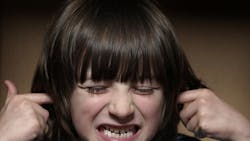The Corner Cubicle: The Golden Rule of Hearing Protection
Is it just me, or is this world getting louder?
I live within walking distance of downtown Cleveland. Noise – nonstop, unrelenting noise – is part of the package. As I’m sure is the case in any major city, the constant whir of cars, trucks, buses and motorcycles is just the baseline.
The bombastic bass of subwoofers from passing cars penetrates the very foundation of our house (I can only imagine what it’s like inside the car). The call and response of the neighborhood dogs yipping and yapping at each other over their fences is nothing short of pandemonium. The constant cacophony of screaming police sirens and wailing ambulances seems to signal that the end of the world is nigh.
And there are the horns.
Motorists, as you might have noticed, whack their horns at the slightest provocation (for example, whenever the car in front of them hesitates for a nanosecond at a green light). The commuters who use our street as a cut-through seem to relish their inalienable right to honk – early and often – at anyone who isn’t a perfect driver like they are. On top of that, Cleveland’s transit drivers have been instructed to honk their bus horns relentlessly for safety. And they do.
I’m convinced that Quicken Loans Arena – the place where LeBron used to play will play again! – is the loudest place on earth. The pre-game introductions at a Cavs game are an audiologist’s worst nightmare: fireworks, explosions, thousands of screaming fans in an enclosed space … and a P.A. system that’s cranked to the equivalent volume level of an F-14 taking off.
It had been a year or two since I last was assaulted by the arena’s aggressive sound system … that is until a few weeks ago, when I attended a Cleveland Gladiators game (that’s arena football) with some co-workers.
I'm convinced that Quicken Loans Arena is the loudest place on earth.
I brought a set of foam earplugs with me, but I kept them in my pocket at first. It had been a year or two since I’d been to “the Q,” and I’d forgotten how loud it was. On top of that, I wanted to be able to converse with my co-workers, and earplugs can make it challenging to hear people – especially in an arena that has a section called “Loudville.”
And, to be honest, I was a bit self-conscious about wearing earplugs in a social setting. It seemed, well … a bit dorky.
To make a long story short, I quickly realized that every man, woman and child in that arena was at risk of hearing damage from the Q’s fully tweaked P.A. system. So I put in my earplugs just before halftime and never looked back.
As it turns out, I made the right decision. Howard Leight by Honeywell has created a “noise thermometer” that shows the potential hearing risks of workplace noise as well as non-occupational noise, based on OSHA’s permissible exposure limits. According to the chart, typical stadium noise registers around 117 decibels, while a rock concert hits 120 decibels (which is roughly the equivalent of thunder or a taxiing jet plane). I’m guessing the noise level at the Q was in the same ballpark.
In OSHA’s opinion, exposure (of any duration) to noise above 115 decibels is not permitted without hearing protection.
Get into the 120-decibel range and you’re risking severe irritation to the ear. Exceed the 130-decibel level (a balloon pop, believe it or not, is 157 decibels) and you’ve crossed the immediate pain threshold. Get into the 160-decibel range (fireworks are 162 decibels) and you’re at risk of immediate physical damage.
The chart got my attention because it highlights the hazards of everyday noise. A hair dryer (80 decibels), a blender (85 decibels), a power lawnmower (94 decibels) and a crying baby (110 decibels) all pose the potential to hurt your hearing. And unlike other parts of the body that heal, your hearing is a nonrenewable resource.
Your hearing is a nonrenewable resource.
Those of us who focus on occupational safety and health every day already know this stuff. But as I learned recently, knowing the right thing to do isn’t always enough. Doing the right thing can get derailed by any number of factors, from peer pressure (real or perceived) to time pressure to outright carelessness (or laziness).
Fortunately for me, a recent article by Theresa Schulz on EHSToday.com delivered a pertinent message when I really needed to hear it: “The most important rule of hearing protection is to wear it!”
I’m a believer.
Send an e-mail with your thoughts to [email protected].
